14 Types of Almonds to Explore in Your Snacking Adventures
Author: Anne Cowart | Editor: Omar Alonso
Review & Research: Jen Worst & Chris Miller
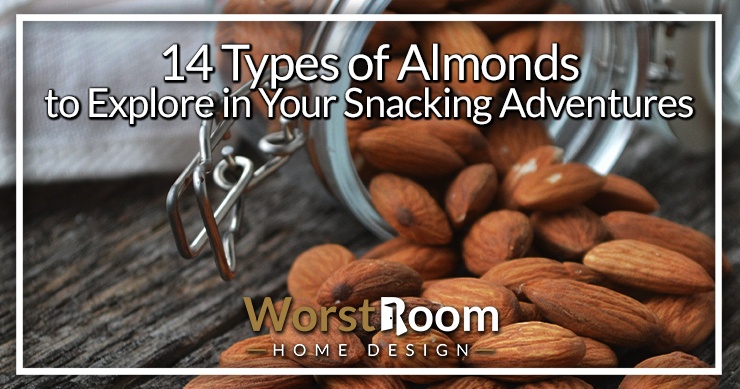
For being the king of nuts, numerous types of almonds are cultivated and consumed every day all over the world. Almonds are highly nutritious, containing rich amounts of protein, fibers, vitamin E, minerals, and healthy fats.
If you're a health-conscious person, almonds will make a very good snack for you as it doesn't contain any cholesterol, unlike some other nuts.
Since almond varieties grow naturally as well as are developed artificially in the labs, they largely vary in their characteristics, taste, and nutritional contents.
To assist you in picking the best type of almond, we will discuss the environmental needs, nature, availability, and identifying features of the most popular and nutritious almonds. Without wasting any more time, let's dive right in.
14 Types of Almonds
Almonds are basically the edible seed of the almond trees, which belongs to the family Rosaceae. Although the plant is native to Iran and neighboring countries, many cultivars have been improved to suit all kinds of environments.
The history of almonds extends all the way back to 1,400 BC where the nut was even mentioned in Greek mythology and the Bible. Fast forward to today and the state of California in the USA grows 80% of the world's almond supply.
Here are some widespread almond types from every part of the world:
Nonpareil Almonds
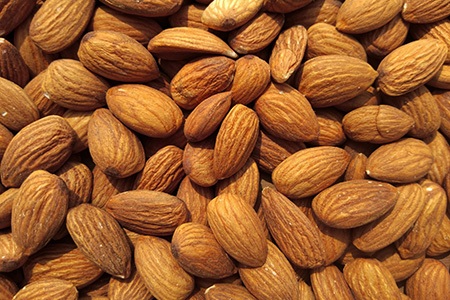
Developed by A.T. Hatch of Suisun, nonpareil almonds are readily available and produced commercially all over the United States. You can easily identify them from their light brown color and somewhat elongated, smooth, and flat surface.
These almonds have a very thin shell that can be readily blanched for blemish-free, smooth processing. Nonpareil almonds have a naturally sweet flavor that intensifies after being processed. Also, these nuts contain a high percentage of fat, calorie, and protein.
Compared to other almond types, the nonpareil tree is an early bloomer as well as an early producer. It grows 15 feet in length, and the production peaks in early spring and fall.
Although the plant prefers full sun, it can withstand the harshest environmental conditions. Hence, you can easily grow these kinds of almonds in your home garden.
Mission Almonds
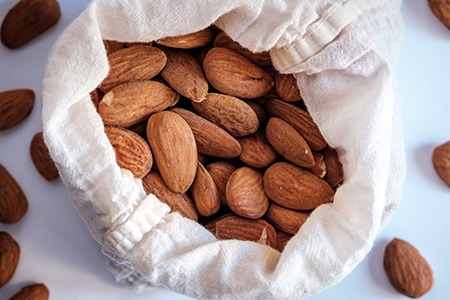
With their super hard shell, mission almonds are famous for their toughness. It grows well in hot and dry areas of the united states. As the shell is thick and stout, the small kernel remains intact. The color of mission almonds is dark brownish-red, which makes them easily distinguishable.
Compared to nonpareil almonds, the flavor of this type is stronger and sweeter. You can further improve the flavor by roasting. Mission almonds are great to eat with snacks, desserts, and most types of ice cream.
Although the hard shell makes it difficult to process the almond, it protects the almonds from insects and harsh weather conditions. Due to the deep wrinkly skin, blanching is not a common option for these almonds.
Mission almond trees are late-producers and take 3 or more years for their first production. These types of almonds will rise 10 to 15 feet in height and grow well in sandy and loamy soils. You can expect 30 to 50 pounds of production each year from a single mission almond tree.
Mollar Almonds
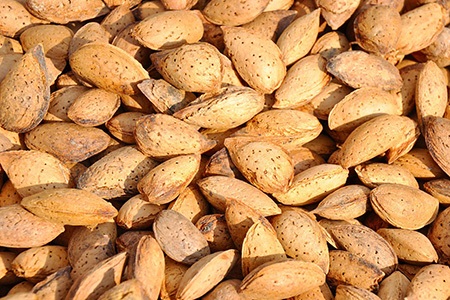
Originated from Spain, this type is also called Mollar de Tarragona. These almonds have a very thin and soft shell that makes them easy to consume and process. The flavor is sweet and succulent that leaves a long-lasting impression.
Mollar almonds have a very light brown color and a pear-like shape. Because of the smooth skin with small sutures, blanching the almonds is pretty easy. Hence, the almonds come at a low price and are produced largely in Spain and India.
As for the plants, they are fast-growing, evergreen, and deer resistant. They grow well in tropical areas and start fruit production in October. They're great on salads, as types of garnish, or as trail mix snack mixed with chocolate, types of pecans, pistachios, and other nuts.
Carmel Almonds
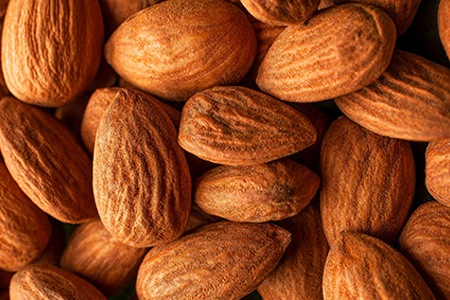
Often classified as a California almond, these kinds of almonds are found in its shelled form. Carmel nuts have a long and flattened shape similar to nonpareil almonds.
The variety was first introduced in Le Grand, California, and went on to be a very famous crop all over the United States.
Although the shell is thin, it has good integrity. You can easily recognize the almond types from their soft, slightly wrinkly, tan brown skin. For its sweet taste, carmel almond is baked and roasted to use in candies, desserts, and dry fruit mixes.
Carmel almond trees are early producers and provide a huge production every year in September. It works as a great pollinizer for the species of nonpareil almonds.
Peerless Almonds
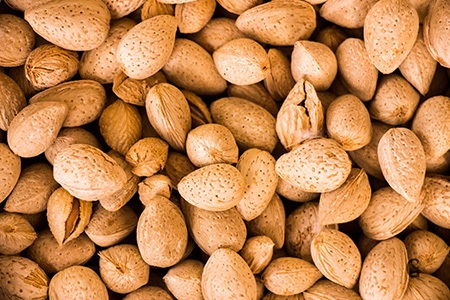
Native to the United States, peerless almonds are produced for their rich flavor and ease of harvesting. The medium-sized almonds have a semi-hard shell that is covered by green skin before ripening.
Also, the shell of these types of almonds have decent integrity with no suture opening, and so, the kernel is protected from insect infestations. Peerless almonds have a light color and quite a smooth surface.
Peerless almond trees are very large, reaching up to 20 feet in height or even a bit more. They grow in virtually all soils and provide their first production in just 2 years and reach full fertility in 4 years.
Usually, the trees are incapable of self-pollination and require at least two other varieties of almonds for cross-pollination. As peerless almond trees don't survive frost, you need to plant them in a fully sunny area where the climate is dry and hot.
Butte Almonds
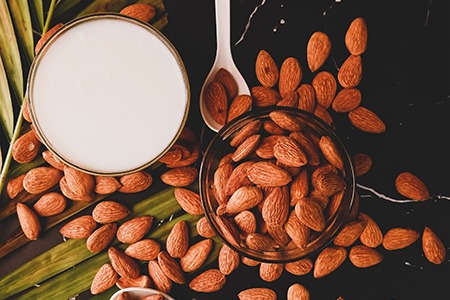
Butte almonds are extremely popular around the globe. Part of the fun is in earning the nut by having to crack open the shell, which is only semi-hard and thus not too much of a chore.
Their appearance is lighter in color relative to the other different types of almonds, and have a smoother surface to them. They're smaller, though, both in width and in length, but do have a generous diameter to them.
Fritz Almonds
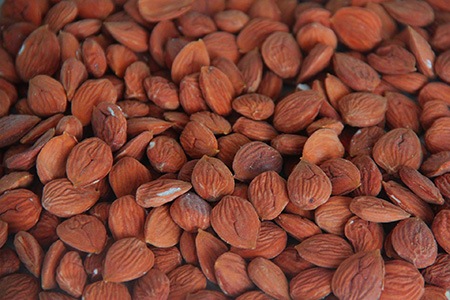
Fritz almonds are comparatively smaller than most varieties and come only in their shelled form. Despite being small, the dark-brown nut is plump, with a high-quality, rich-flavored kernel.
Also, the shell is pretty hard, featuring a low suture for easy blanching. With fritz almonds, you need to be extra careful as they are vulnerable to bird damage.
In comparison to nonpareils, the fritz tree takes 40 to 60 days extra for maturing crops. The tree is huge, reaching up to 33 feet in length. It requires cross-pollination with the Mission almond varieties, and you can expect mass production of these different kinds of almonds from early April.
Sonora Almonds
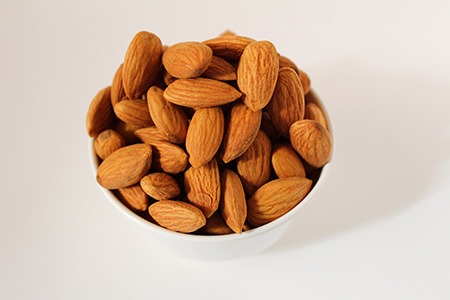
Being one of the healthiest nuts, sonora almonds are extremely popular among health-conscious folks. Sonora almond contains 24g fat, 10g protein, and 290 calories.
As a great nutrition source, these almond types are often mixed with various types of milk, warm honey, and savory dishes, or consumed raw. The nuts have a poorly-sealed, paper-thin shell that encloses large, elongated, and light brown kernels.
Sonora almond tree is an early producer and you can harvest crops just after harvesting the nonpareil varieties. As the tree is susceptible to frost, you need to judge the weather conditions before planting.
Padre Almonds
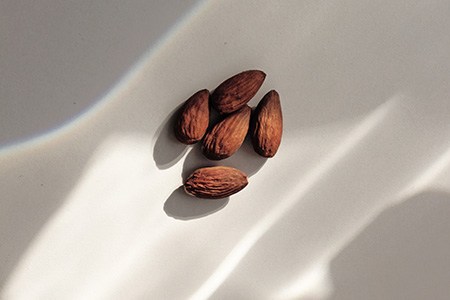
These types of almonds comes only in their shelled forms. Padre almonds are short and plump with a round shape. The nutritious kernel is packed inside the hard, nicely sealed shells of good integrity.
As for the skin, it's dark brown and wrinkled. Hence, the surface is suitable for blanching and holds seasoning pretty well. You can plant the tree in any climate as long as the temperature is over 20 degrees Fahrenheit.
Padre almond trees prefer full sun and partially shady areas. Although well-drained, moist soil is preferable, you can grow them in any soil type. This variety is also an early producer and harvests in August or mid-September.
Ferraduel Almonds
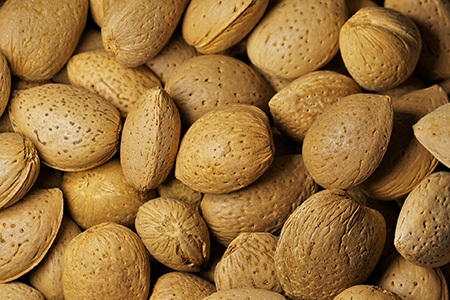
Though most almonds types these days come from California, there are some that come out of France and one of those almond varieties are the Ferraduel almonds. They have a wider size to them compared to others with a harder, flatter dark brown shell to be cracked.
Marcona Almonds
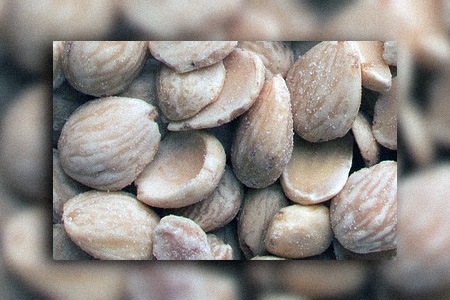
Not content to let France steal all the attention, Spain brings us the wonderful Marcona almond varieties. These varieties of almonds are more popular in Europe, the Mediterranean nations, and in India.
They have a softer texture to them and are relatively moist compared to their counterparts, and they also have a sweeter taste, making them an attractive snack. People like to roast them, eat them raw, and even fry them.
Neplus Almonds
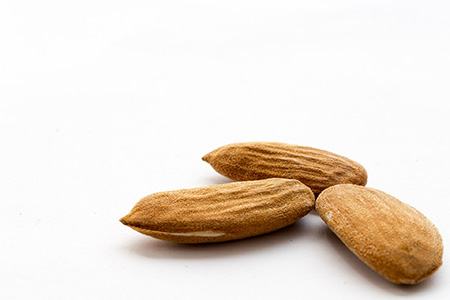
Neplus almonds hail from France but are considered a Calfornian variety. They're very sweet and have a pleasing shape, being longer and flatter. Their color is a light brown with just enough wrinkles to give it a fun texture.
One of the reasons these types of almonds are so popular is probably due to exposure. They're grown due to how much yield one almond tree can produce. So they're kind of "stuffed down our throats" by the farmers and then by ourselves! You can garnish nearly anything with them like ice cream alternatives, for instance.
Monterey Almonds
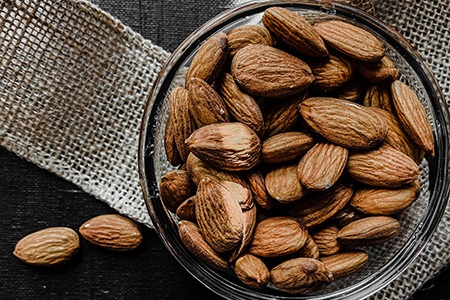
If you're looking for an almond tree that perfectly suits your pots and containers, monterey almond trees will be an ideal choice.
The tree will take only 12 feet of space in your garden and grow up fast, even with low maintenance. It can serve as an excellent pollinating companion for other nonpareil almond varieties of your garden.
Monterey trees are incredible producers, and they start delivering crops just in 1 to 4 years. However, the crop is harvested late, roughly 4-6 weeks after the harvesting of nonpareil varieties.
This can be a problem in some areas where heavy rainfall occurs during September. So you need to keep these weather factors in mind while planting the tree.
This variety is mainly grown for its tender and sweet flavor. The surface of the nuts is dark brown and deeply wrinkled. As for the shell, it's hard, well-sealed, and easy to process. You can eat those large nuts fresh or dried with your snacks.
Aldrich Almonds
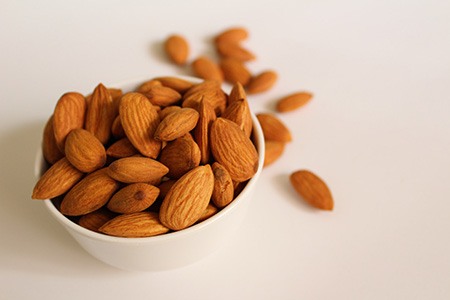
Although the Aldrich almonds are one of the rarest, it's a favorite type to many consumers because of their unique and excellent flavors.
They have a distinct and aromatic macaroon flavor that most people find extremely delicious. Also, the quality of the kernel is pretty high and more consistent compared to many other foreign varieties.
Aldrich almond contains 4g dietary fiber, 14g fat, and 160 calories. The shell is soft and tightly sealed. Even in raw condition, Aldrich almonds are very crunchy, even more than nonpareils.
Although the trees grow pretty high, you can keep them compact by regular pruning. Aldrich almond trees harvest late in August or in early September.
Types of Almonds That Make the Perfect Snacks
As most varieties of almonds aren't self-compatible, growing 2 or more almond types is better for increasing pollination chances. So choose some compatible almond species to get the most nutritious harvest in a few years.
Now you know all the delicious, different types of almonds that you can grow in your backyard. If you plant the trees in a suitable climate, the trees will grow in any soil type with minimal upkeeping.




